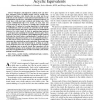Free Online Productivity Tools
i2Speak
i2Symbol
i2OCR
iTex2Img
iWeb2Print
iWeb2Shot
i2Type
iPdf2Split
iPdf2Merge
i2Bopomofo
i2Arabic
i2Style
i2Image
i2PDF
iLatex2Rtf
Sci2ools
TCAD
2008
2008
Transforming Cyclic Circuits Into Acyclic Equivalents
Abstract--Designers and high-level synthesis tools can introduce unwanted cycles in digital circuits, and for certain combinational functions, cyclic circuits that are stable and do not hold state are the smallest or most natural representations. Cyclic combinational circuits have well-defined functional behavior yet wreak havoc with most logic synthesis and timing tools, which require combinational logic to be acyclic. As such, some sort of cycle-removal step is necessary to handle these circuits with existing tools. We present a two-stage algorithm for transforming a combinational cyclic circuit into an equivalent acyclic circuit. The first part quickly and exactly characterizes all combinational behavior of a cyclic circuit. It starts by applying input patterns to each input and examining the boundary between gates whose outputs are and are not defined to find additional input patterns that make the circuit behave combinationally. It produces sets of assignments to inputs that toget...
| Added | 15 Dec 2010 |
| Updated | 15 Dec 2010 |
| Type | Journal |
| Year | 2008 |
| Where | TCAD |
| Authors | Osama Neiroukh, Stephen A. Edwards, Xiaoyu Song |
Comments (0)

